SEEING SKY: STEP 1, STRENGTH – By JustAddBacon
Written by JustAddBacon. Edited by AlphaSapphireX
Howdy everyone! My name is Just Add Bacon and I have a wonderful new series of articles that I am quite proud to be revealing. Due to Marcelo purchasing my soul, I am now contractually required to produce wonderful new content for y’all lovely weavers every two weeks. So, to fulfill my end of this faustian bargain, I hereby present Seeing Sky, a new series where I am analyzing the main prisms of Sky. I hope y’all enjoy this series as it rolls out over the next two months, and should y’all like it enough, dual-prism analysis could also be done in the future. In any case, be sure to leave me your feedback in the discord, and enjoy the article!
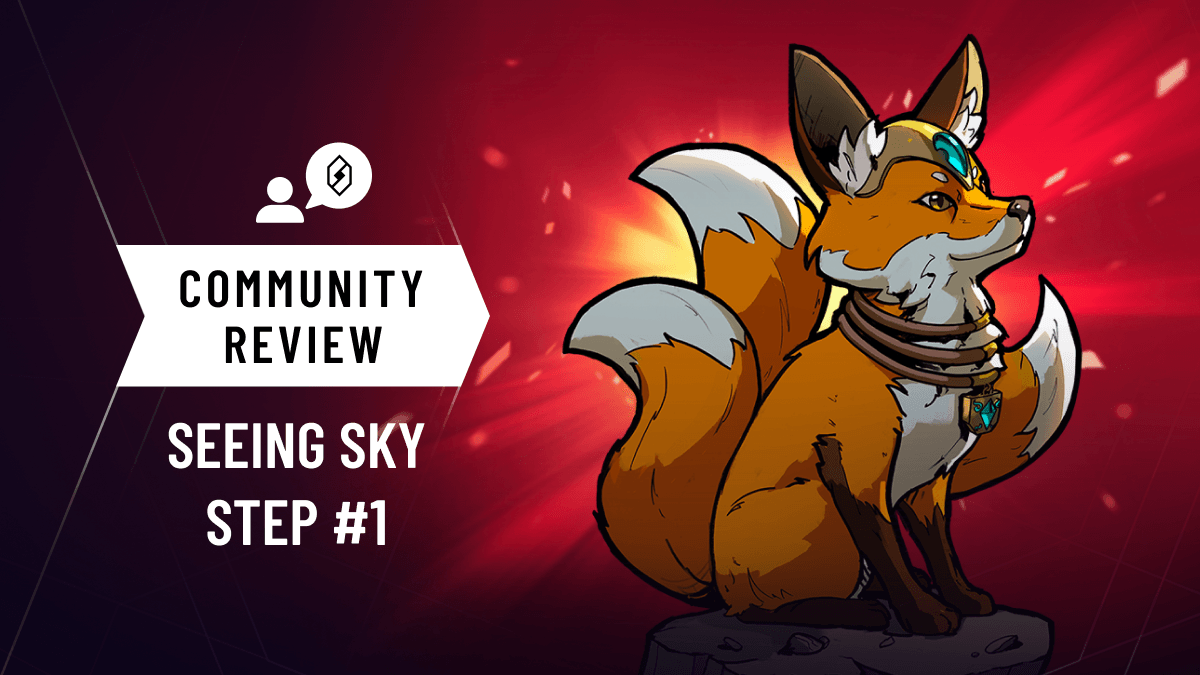
Note: This article, along with all others in this series, are written with the assumption that readers have already read the corresponding piece in Designing Sky, lead game designer Coulter Baker’s series. This will not be necessary to understand these articles, but they are both highly informative and authoritative sources of information on the prisms. For convenience, the corresponding article will be linked in each piece, and it is recommended that they are read first. Additionally, by popular demand all decks mentioned in the article will have a sample string at the end of the article.
https://www.skyweaver.net/news/design-strength
LORE
The Prisms of Sky are mysterious things, working in ways not fully known to its denizens. However, there are currently five prisms that have been identified: Strength, Agility, Wisdom, Heart, and Intellect. The Strength Prism is the Prism of conviction; its bears have wills of iron. These are the Weavers of determination, those who refuse to back down.
The Strength Weavers of Sky are a diverse bunch, but they do all share in the Strength of their convictions. Ada and Titus both have an intense desire to protect, although they differ on the object of protection; while Ada wanders in search of those in need, like a knight errant, Titus is more focused on specific environments and the lives dwelling within. However, the Strength Weavers come in other varieties, as do all Weavers. Mira’s intense drive expresses itself through her engineering, as she believes in trying to design a better world for all. Additionally, Fox and Horik are slightly more ambiguous, as their motivations are currently somewhat enigmatic. Fox is a vagabond, and seems to be trying to leave some type of past behind. My personal theory is that he might’ve had past connections with Armis (whatever he’s running from, it must be something *worth* running from), but that’s based on evidence from only a few lore bits.
Horik, however, seems to be in the most ambiguous position. Numerous quotes from him already establish his personality as being more domineering and aggressive than the other Strength Weavers. He refers to the weaker as “lesser beings” (Icy Touch) and calls the Hoplite’s traditions “pathetic” (Frog King). However, the most concerning things come from cards like Molten Heart, Flame Phoenix, Sunder, and Undragon’s Pact. We don’t know what kind of path he’s on, but it is certainly a concerning one.
DESIGN STATS
All Stats Courtesy Of Horizon. Special thanks to Matta for putting up with my pedantic requests:
- Avg. Strength Card’s Cost: 3.857 (Avg. Generic Card’s Cost: 3.4034)
- Avg. Strength Unit’s Cost: 3.9572 (Avg. Generic Unit Cost: 3.6138)
- Avg. Strength Spell’s Cost: 3.49 (Avg. Generic Spell’s Cost: 3.1394)
- Avg. Strength Unit’s Power: 3.3714 (Avg. Generic Unit’s Power: 2.9277)
- Avg. Strength Unit’s Health: 4.3429 (Avg. Generic Unit’s Health: 3.5972)
FULL PRISM METRICS
Common single target removal
- Strike Down, Hyper Beam, Sunder, Mortal Blow, Chomp
Common AoE removal
- Burninate, Kha’s Wrath, Tiamat’s Rage
Common punish options
- Buster, Squire, Jungle Guide, Nurtured Bond, Chomp, Kha’s Wrath
GENERAL DESIGN
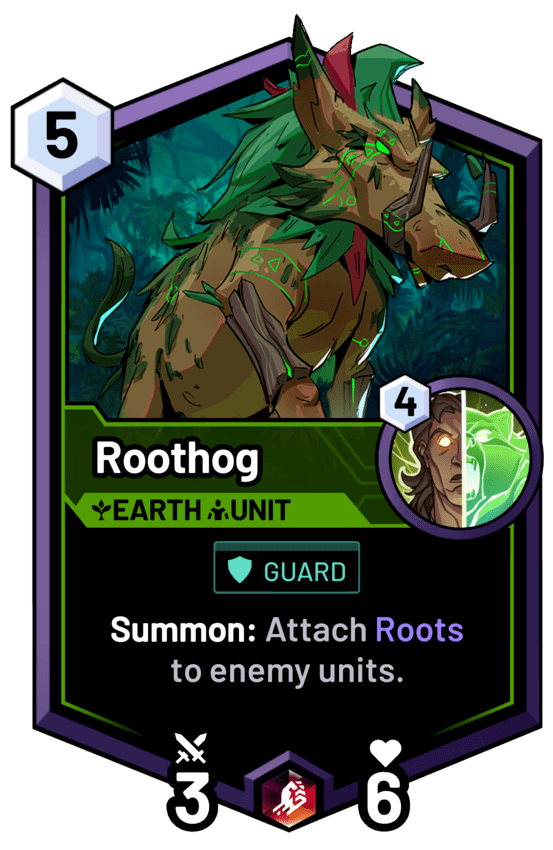
The Strength prism is predicated on a feeling of power. Befitting its name and theming, its units, spells, and trends all embody this most fundamental idea. Aggressively statted units such as Gladiator, Roothog, and Geode exist at every point along its curve, and potent removal options like Strike Down, Hyper Beam, and Sunder promote board control for the prism. While Strength lacks draw options, it has plenty of tools for value generation. Firesight is one of the cheapest +1 draw options in the game, and Burninate and Wrath can clear numerous units at once.
To begin, the units in Strength are consistently some of the best statted in the game. At the bottom of its curve, Axolotl is almost always the bulkiest of the 1-mana-Banner options, perhaps only rivaled by Mecharai. Flashbang is a consistently safe opening for the prism, while options like Amalgam and Unikron can also provide safe ways to control board in the early game. More aggressive options like Engine Blade and Ember Wolf also exist, but their vulnerability to Banner generally means they are unpreferable. However, their fire and metal elements mean that they may see use in specialized decks.
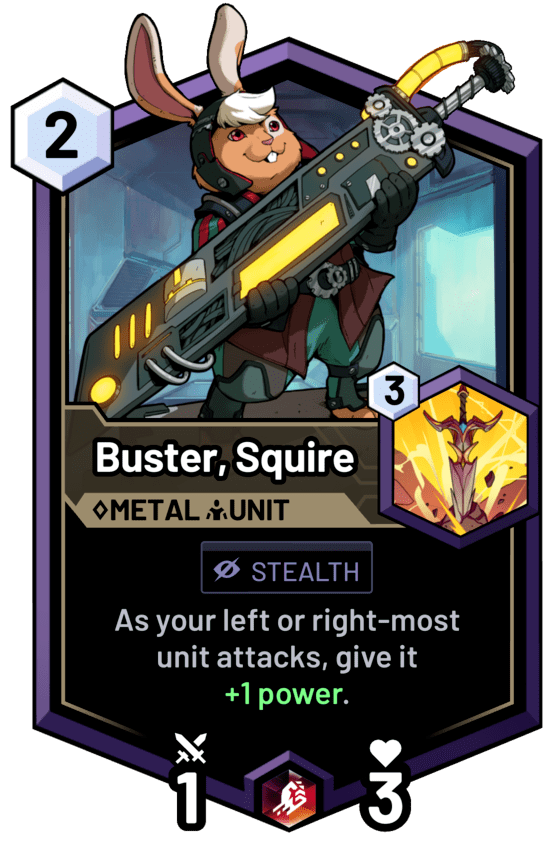
At 2 and 3 mana we see strength’s units trend into a generally offensive, board heavy focus. Many options have Guard, and many of them require specialized tools to answer. Fan Dancer, Grimstone, Halcyon, Gladiator, and Oliphant can all present an early wall for unprepared decks, leveraging beyond average stats and/or unique effects to make a full clear difficult, or at the very least, inefficient for the opponent. Buster, Squire, also deserves special mention here, being a powerful punish option for the prism.
Strength also has a fair number of threats at this level. Gladiator, Griff Scout, and our aforementioned Lapin are all massive threats when unanswered, and come at points where answering them efficiently may be costly. A turn 2 player 2 Squiddy generally requires something like a Strike Down, Water Rune, or Grim Reprisal to answer, but removing those options from consideration early in the match carries its own side benefits. Psyche is also worth mentioning here, just for its massive statline and weak threat of draw.
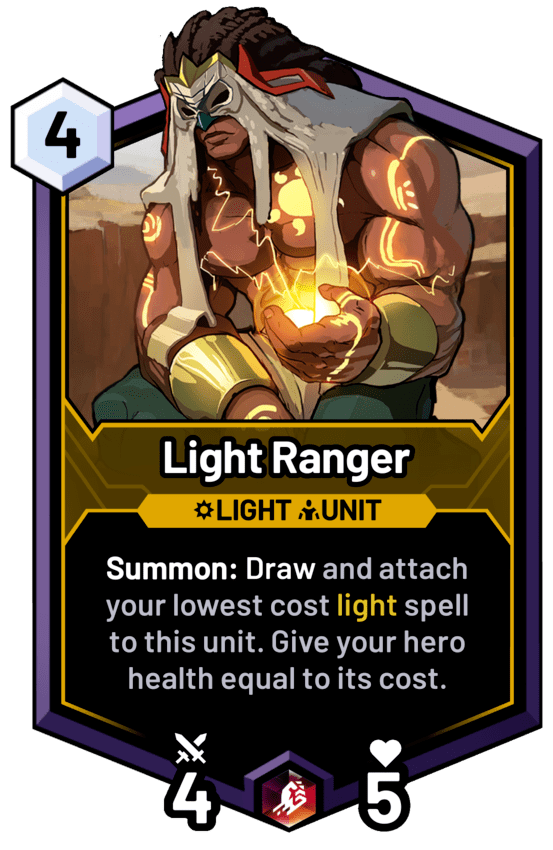
At the midrange section of units (costs 4-7), we see the prism diversify its strengths, and it gains new ways to promote beatdown strategies. At 4 mana, Strength gets its only spell-searcher, Light Ranger, but it is a welcome addition to its options. Inside the prism, Light Ranger has access to options such as Call to Action, Glorious Mane, and Kha’s Wrath, which all grant it a useful function in numerous Strength decks. Aside from making up for some of the value generation that Strength is otherwise lacking, it also provides a nice bit of healing, which is useful for a board control based prism (for reasons we will later discuss). Other standout units here are options like Oni Smith, Heavy Cavalry, Khan, Roothog, Geode, and Mothermander. Many of Strength’s best units are hard to answer with generic removal, and generally also provide immediate board control. Heavy Cavalry and Geode are especially nice together, as Cavalry can reliably find Geode for a harsh turn 5 -> turn 6 curve. When using these units, however, be wary of potent aoe options like Hyper Beam, Germinate, and Mass Confuse. Mass Confuse may not fully clear, and a low hand size will weaken Hyper Beam, but both are still things to be wary of.
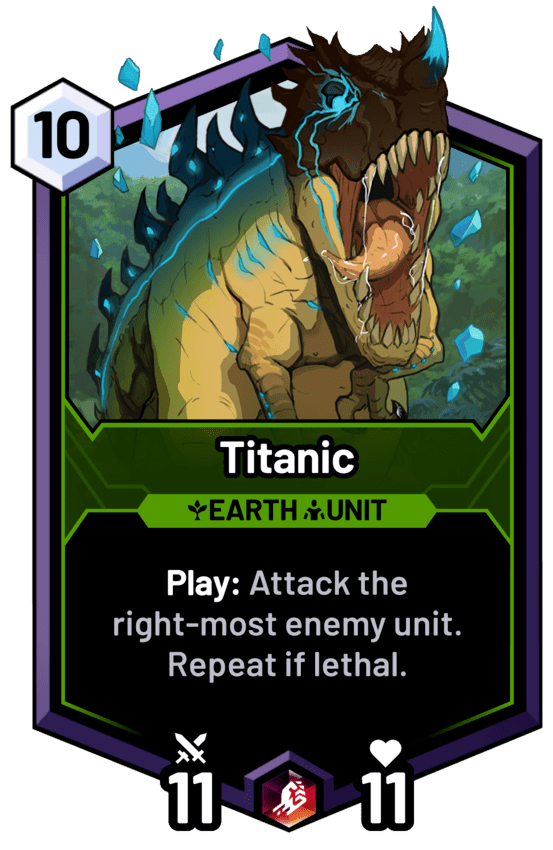
The top end units of Strength boasts a small but exemplary collection of finishers. Options like Colossoid and Moltenous are not often played (vulnerability to cards like Chomp, Deactivate, Encapsulate, and Kha’s Wrath make them risky) but provide extremely powerful death effects for controlling board. Developing either unit versus aggro can often decide a game, either through Colossoid’s burn or Moltenous resetting board. Tiamat’s Banner is more helpful than one may think at first glance, and the sooner in the game it is played the more likely it is to win. Titus can summon her early with Etherwail, and Horik can ramp into her with Old Fogey and Opal Golem. For the enterprising deck builder, one hero can even play her on turn 3 with the right hand, but I’ll keep that one secret for now.
Finally, B.F.R. and Titanic are unique, game-winning options for control decks. Introduced in Clash of Inventors, B.F.R. is a powerful unit, working as essentially a single-target kill option while also providing a substantial buff to all your available units. With things on board, the threat of B.F.R. constrains the opponent’s plays immensely; they’ll need to answer your board to avoid a massive swing, and also try to avoid developing good targets for our robot. Even without board presence, B.F.R. can provide durability to your hand, making it pair quite well with our next unit, Titanic. This lovable dino is the final unit, but is perhaps one of the most influential in the prism. Its massive 11 power means that no base unit in the game (currently) can survive its attack, and its repeated triggers means it can clear through an entire board of over-statted enemies. Using this unit as a complete aoe isn’t exactly preferable, Burninate and Kha’s Wrath are usually better options, but Titanic is functionally a guaranteed one-sided clear. Against aggro decks, Titanic can even survive his clear, usually threatening lethal at the same time. Setting it up effectively may be difficult, but it can easily win games.
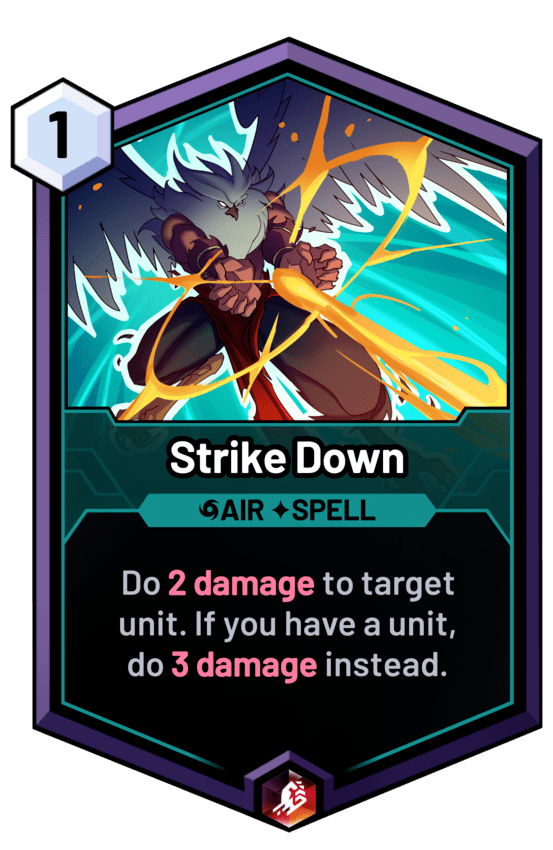
In the spells category, Strength primarily focuses on board control. Aside from Call to Action (which buffs a unit) all of Strength’s 1 mana spells interact with the board. While it doesn’t have the universal removal options like Wisdom’s Incinerate or Intellect’s Water Rune, Strength still has a good listing of generally strong removal tools for the early game. Strike Down exists at a crucial break-point of dealing 3 damage for 1 mana. 3 damage will remove not just a bulk of units in the game, but almost every common opening play from other prisms. Sunder and Hyperbeam are also notable options for Strength, providing great ways for the prism to bust down larger targets without running clunkier options like Mortal Blow. Strength also possesses more buff spells than any other prism, and these spells help make its early game threatening. A turn 1 Flashbang or Unikron isn’t much of a threat on its own, but a Flame Sword follow up can quickly ratchet up the pressure.
Draw and AOE options for Strength are linear, yet potent. Firesight is one of the cheapest +1 spells in the game, but has an acrimonious recoil that makes the option agitating versus aggro. Crystal Cache is technically a 2-mana draw spell with Banner, but in practice that value is often delayed, reducing the spell’s usefulness. Its stringent requirements of a spell and unit make it demanding to build with, but it also lends itself to a high level of targeting as a result. Aoe options like Volcanic Blast and Burninate are powerful tools, and synergize well with Firesight. Outside of Strength, Crystal Cache can be used to find good Anti-aggro aoe like Salvage, Chain Storm, and It’s a Trap, helping lend Strength some synergistic value for control decks. Ether Mask can be an option for finding Titanic by turn 10 reliably, and perhaps also pick up Crystalceratops, but, as mentioned, using Titanic for purely aoe purposes isn’t extremely preferable.
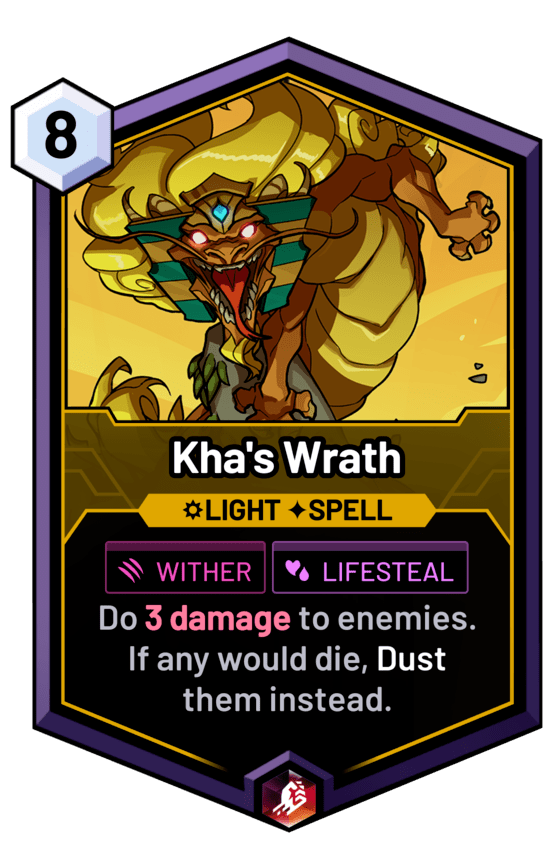
One final thing that needs to be mentioned is Strength’s disruption tools, because they are very limited but very defining. Brimstone (Burn to a Crisp), Unstoppable Chop, Chomp, and Kha’s Wrath are justifying factors for a deck to be in Strength, and for good reason. Death effects are consistently potent in Skyweaver (Eclipse, Timber, Sky Phoenix) and a reliable way to negate these is useful. Additionally, all of these except for Unstoppable Chop have the capacity to do damage to face, meaning that they have a versatility that makes them safe options for multiple matchups. While these options are all good, they are also essentially the only disruption tools that Strength has in its spells, meaning that they can be played around with good planning. Keep these spells in mind as long as they are good in the meta.
GENERAL PLAYSTYLES
The playstyle of any prism is generally predicated on what it can do better than another prism. In the case of a dual prism deck, the question then becomes why to pair one prism with another, either as why to have Strength to bring the main cards, or why use Strength to complement the main prism? I argue that the optimal function of Strength cards is pursuing board control, and so the Strength prism is best suited towards either a board heavy playstyle or supporting a prism with weak board control.
Aggro decks get a lot out of Strength’s board control tools. Aforementioned removal options like Strike Down and Sunder are highly tempo-efficient, and help the deck secure board. Its units with potent stats like Sidekick, Unikron, Rubble Devil, and Gladiator can be reliable ways to take board control early in the game, which is a viable method for aggro decks to begin rushing face for lethal. It also possesses a number of relatively safe options at early costs (Brimstone, Halcyon, Flashbang, Amalgam) that help an aggro deck draw out its opponent’s answers before developing threats. Strength also possesses some threatening midrange options that an aggro deck can use to supplement their curve. Demon Pact is functionally a buff spell that gets better the weaker the unit it’s used on, which means it pairs incredibly well with poorly-statted 1-mana units from other prisms like Canopy Archer, Icaru, or Gato. Heavy Cavalry again makes an appearance, as it gains a wide slew of valuable targets in dual-prism aggro decks. Options like Righteous, Xythe, Ghost Duster, Gemini, and Buster, Squire are all potent and reliable, and help supplement areas where Strength is lacking.
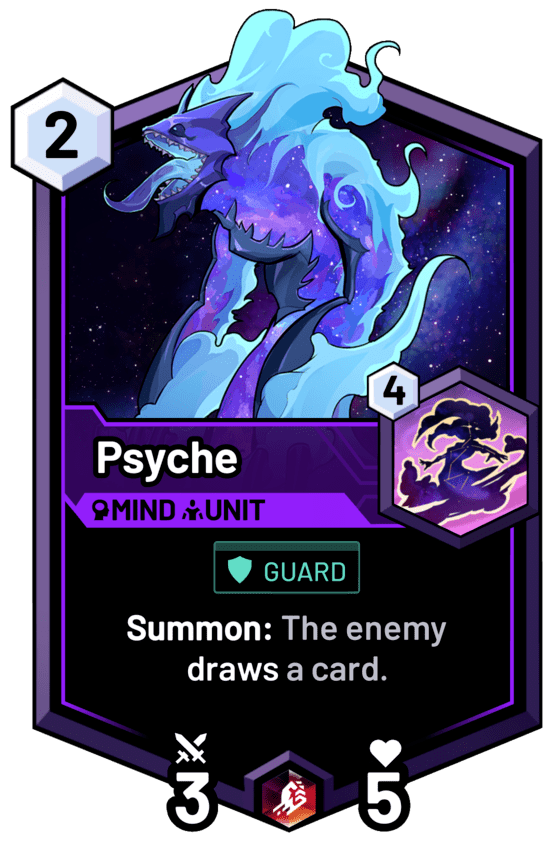
One deck that makes exceptional use of these elements is Fox Burn. Here, as with any burn deck, the win-condition is dealing direct damage to the opponent, either through aggressive plays or effect damage. For this deck, options like Chomp, Wrath, Psyche, Sunder, Brimstone, and Buster, Squire all play very important roles, allowing the deck to consistently pump damage into the enemy hero. While Strength and Agility are both generally lacking draw options, Firesight has strong synergy with many of Agility’s strong fire options, like Fire Rune and Hot Dog, and the deck aims to close games before draw power becomes relevant. However, as both prisms lack reliable healing or damage-prevention options, the list is vulnerable to being worn down.
Midrange is perhaps a more obvious application for Strength, given the general trend of its units to have better stats relative to other prisms. Frank, Roothog, Khan, Heavy Cavalry, Garuda, Ifrit, Psyche, and Geode are some of the best-statted units in the game for their cost, and the fact that they all exist in the same prism helps decks take advantage of the synergistic value between these cards. For a midrange deck, the most important thing is having better stats than the opponent, and being able to leverage them to generate value. To this end, we’ll need good removal from the supporting prism, and ideally some options to supplement Strength’s value deficiencies.
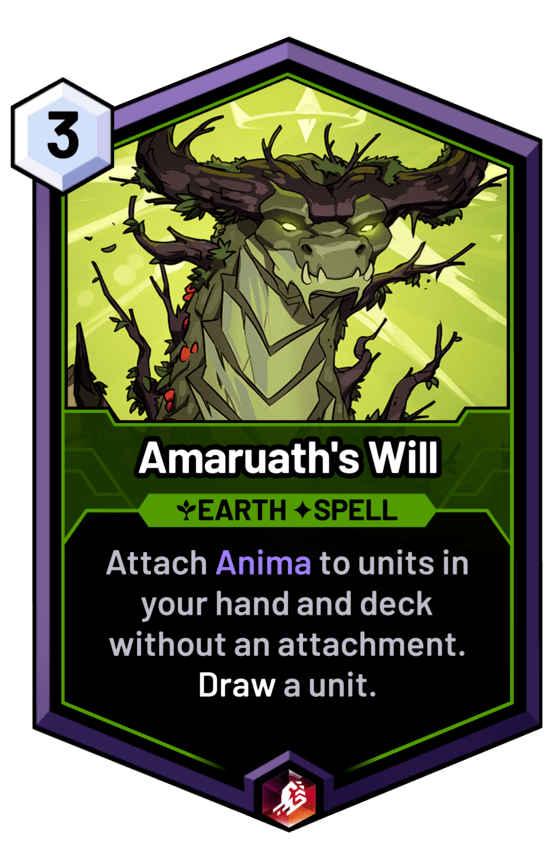
In the midrange category, Mira Will provides a great case study. Here, a key card is employed as a build-around, Amaruath’s Will. Will grants every unit in your hand and deck anima so long as it has no attachment, and is also kind enough to also draw a card. On its own this would do very little, but within the Intellect prism there is a wide range of efficient ways to trigger the anima. So, with these two things done, Mira quickly develops units with substantially above-average stats, and proceeds to plow through the opponent with them. Contrary to Agility, Intellect has strong hard-removal tools, like Mass Confuse, so it is also capable of wallbreaking effortlessly. Additionally, options like Cross Reference, School of Fish, and Enigma Golem can efficiently make up for Strength’s lack of resource generation. However, the deck lacks the effective damage reach that Agility has, and so can potentially be walled-out more.
Strength as a control prism at first seems awkward, but I think Strength is actually deceptively good at control. Strength’s primary advantage over other prisms is its well-statted units and strong tools for board control. In the context of a control deck, this lends itself towards a proactive style of control that often finds itself curving removal options while developing the occasional wall of units. Options like Brimstone, Kha’s Wrath, and Tiamat’s Rage can generate good value for the control player, while also allowing it to sneak burn damage past the opponent. Other units like Heavy Cavalry and Roothog also serve classic Control-deck roles, drawing and controlling board respectively, while also not sacrificing their stats to do so. Chromeosaur can weakly fill the ramping role, and options like Dracomantium, Titanic, and B.F.R. can be finishers. However, Strength lacks easy healing, and reliable draw-power, so other prisms will need to fill this gap.
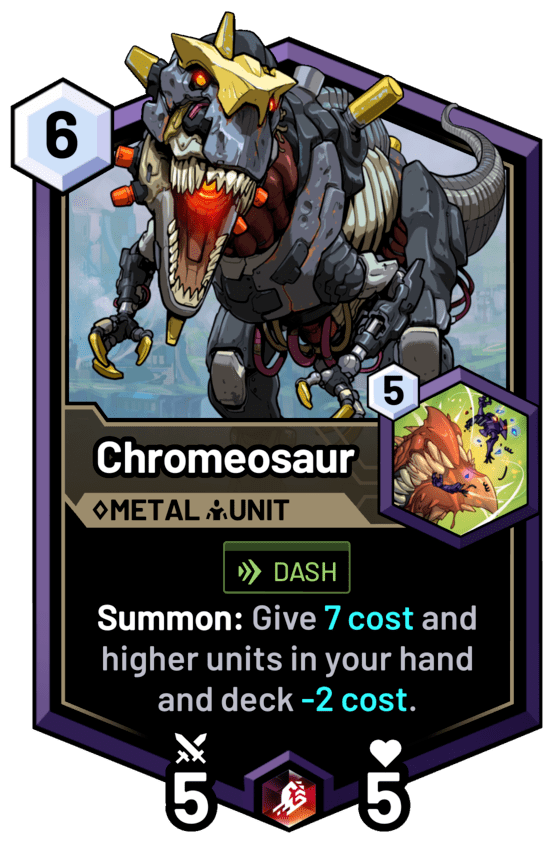
One prism that fills the gap well is Heart, which leads us to our final case study, Horik Control. Ramp is found in options like Old Fogey and the occasional Harbinger, and healing comes from any of Beloved, Raise Arms, Vishiva, Earth Golem, or Lifesteal units. Notably, Light Ranger also now has a wide range of good targets, also making it a better healing option than in just Strength. As for draw power, plenty of Heart units draw, like Crypto, Eclipse, and Chester. Heart also has handy value tools like Unfallow, Evermore, and Ancients Rise. So, the Horik Control list that I personally use, and find great success with, takes advantage of these traits. Strong Strength units like Titanic, Roothog, Ether Lemure, Heavy Cavalry, and B.F.R. make up the bulk of the deck’s stats, while value engines like Pharonis, Eclipse, Undragon, Jar of Souls, and Ancients Rise supplement our late-game. Old Fogey and, to an extent, Chromeosaur provide ramping, while Raise Arms is a useful healing option that also manages our discard pile. With good management, be it from Raise Arms, Temple Watch, or Pharonis, we can set things up to maximize our value from Ancients Rise, hitting more powerful summons like Chromeosaur, Roothog, and Sonic Jammer. While the deck does have some vulnerabilities to dusting and burn damage, it’s rather fun, and I recommend it to people who want to play something off-meta.
STAPLE CARDS
Strike Down
- Just a good removal spell, arguably one of the best 1-mana removal options in the game. It trades favorably against a wide range of cards, and is cheap enough to allow you to develop board while removing a target.
Ether Lemure
- This unit is niche, but it’s a big boon for the decks that use it. 2 mana for a 3/3 with Dash is powerful on its own, and adding Etherwail to hand has a lot more benefits than one would expect. Even if your deck doesn’t actually want to play Etherwail most of the time, your opponent will only rarely know that. This asymmetry creates a threat just by holding the card in your hand, forcing them into awkward plays; if they’re expecting you to Etherwail into a Titanic right on 8, they may not use that Mortal Blow on your Heavy Cavalry, giving you free board control. In the late-game, Etherwail can also just be a handy draw option, being a good way to spend your mana on turns when you mostly want to pass.
Sunder
- Absolutely incredible spell, and a great reason to choose strength. Even against a deck that has no good target for this (there aren’t any), 2 mana deal 2 isn’t terrible. In the realistic case, this is usually a 2-mana option that either kills outright or indirectly kills a very threatening unit. It also provides a harsh answer to hero Armor and a means to sidestep things like Pharonis.
Tune Up
- A very well-crafted draw option that asks Strength to play to its larger units. As a rule, I don’t run this unless I have at least 5 7-mana or higher targets, and 3 of both 3-mana and 4-mana targets, but that deckbuilding challenge is fun in its own right. Mandatory for anything aiming at control.
Claw Swipe
- The ability to bear arms has never been so cost-efficient. Technically, it’s a bit slower than Volcanic Potion, but this is better for an aggro mirror. This card has been crept slightly by options like Torques and Overdrive, but is still pretty reliable if you are trying to answer Heart decks.
Jungle Guide
- A powerful option for elemental builds, especially metal ones. As a 3-mana 2/4 it’s a little difficult to answer, but it will almost always be answered because it’s so powerful if it survives. Impale is also a handy spell, and makes it preferred in metal focused decks.
Light Ranger
- One of the weaker spell-searcher units, but still very good. It’s good for holding board, it heals, and it has alright targets. Kha’s Wrath can be a huge swing off of this, but being a 12-mana combo you may have to wait a bit.
Heavy Cavalry
- One of the most useful midrange units in the game, and also has nice synergies. Armor, Lead, and 4 health makes it difficult to remove, and drawing when summoned makes it trade relatively well against removal. Additionally, its 4 power allows it to trade through a wide range of units, including even things like Fren-Z. Finally, +1/+1 is handy on anything, but Cavalry drawing a metal unit means that the buff is exceedingly likely to apply to an Armor unit, increasing its usefulness even further. For example, an Eclipse at 2 armored health can be answered cleanly with Burn to a Crisp, but with +1 health it must now suffer 2 more damage to be answered, of which a non-Bannered hero attack can not contribute. Most crucially, Heavy Cavalry makes a very reliable target for elemental decks, as it both benefits greatly from buffs, like that from Jungle Guide, Glorious Mane, or Nurtured Bond, and is also a reliable unit for setting up buff spells, like the aforementioned Mane and Bond.
Chomp
- Brutal punish against aggro or heart decks. Just be aware that this is only really good while you have tempo. Otherwise it’s an expensive single-target damage option that’s likely worse than something like Encapsulate. It does do healing burn to compensate though, which may be a benefit in its own right when paired with other burn options.
Burninate
- Classic aoe. Other prisms have spicier options but this is just reliable. Scorch is often overlooked with this card, but it helps the card immensely, providing more value, flexibility, and tempo with the option.
Chromeosaur
- A massive option for big-unit decks. It’s also a dinosaur, meaning it gets bonus-points in any Bacon ranking. Its cost and Dash allows it to comfortably curve into things like Pharonis, or 10-mana units if you have a mana potion available (Chill and Vialet can assist). The attached Chomp usually works as a tacit threat, “answer this or I Chomp for free,” but also occasionally makes it a useful 11-mana option. If you want to abuse this, options like Second Chance and Rise from Scrap can be helpful.
Kha’s Wrath
- Chomp if it was an AOE. This is just strong, whether you’re ahead or behind, but if you’re ahead it can be game-winning. Don’t underestimate its Lifesteal-burn, as it makes the card a much safer play even against minimal boards.
Titanic
- It’s just a big dinosaur. That’s objectively cool. Also it chews through damn near anything. Pair with Evermore for best results.
B.F.R.
- This card forms an amazing offensive core with Titanic. Open with B.F.R. first to buff the Titanic in your hand. They have to answer it, but if they try to use Guard units your buffed Titanic can easily blow through. Then, the second hit buffs Titanic again, along with everything else you had on board or in hand. Similar to Titanic, it works well with Evermore, but its summon effect can also trigger from things like Second Chance, Soul Forge, and Jar of Souls.
SYNERGY WITH OTHER PRISMS
Agility
- Strength brings potent tools for board control, which pair well with Agility’s tempo options. In the early game, Fox has some of the safest tools for developing boards, as well as some of the best for breaking down defenses, meaning his aggression is very hard to properly answer for many decks. Agility also has access to good burn, which helps Fox secure lethal. Neither prism has amazing draw power, but the options they do have pair very well together, so this isn’t much of an issue. Beware of recoil damage though.
Wisdom
- Wisdom has a lot of value-dense cards like Prismata, helping Titus work a brutal control deck in Titus Exhaust. Wisdom also has access to some of the best top-end units in the game, meaning build-around options like Etherwail can be effective. Additionally, Titus has access to a ton of dusting options, including repeated copies of both Burn to a Crisp and Kha’s Wrath, making him a good meta call for dealing with death heavy decks. Strength doesn’t provide much draw power though, meaning that you’ll be leaning heavily on Wisdom’s more generic options.
Heart
- Heart has a ton of draw power in options like Unfallow, Crypto, and Chester. It also carries a lot of great healing options like Earth Golem and Beloved, meaning it can carry all the essential elements of a control deck while Strength solves niche problems (hard removal) with options like Sunder. At the same time, Heart’s cheap Banner options makes Horik surprisingly good at aggressive Zoo builds. Despite all of this, Heart is a prism especially vulnerable to disruption, so be wary.
Intellect
- Intellect’s units have the weakest stats in the game, but Intellect is compensated for this with amazing effects and powerful searching abilities. These can be used to supplement Strength’s value generation weakness, as options like Cross Reference and Tempest Brew can pretty much carry an entire draw engine on their own. Gemini is a brutal finisher, as is Fren-Z, and tricky 1-mana units like Gato and Ghost Duster can supplement tempo similar to many good Agility units. The lack of high-stat units normally holds Intellect back, but Strength-Intellect is the pairing that suffers the least from this design. Just be aware of being out-tempoed by more aggressive builds.
DIFFICULTIES
First and foremost, Strength as a prism can not draw effectively. Even its potent draw tools have limits, and its viable options are quite limited. More hampering for the prism is the specificity of its draw options; While prisms like Intellect or Heart have wide-ranging and versatile draw options (Numerous spell searchers, a large number of units that cycle, cards that passively thin the deck) Strength’s specificity makes pairing its good options difficult at best. This means that any chaining value of strength’s draw options is rather rare to occur. Thus, Strength decks have issues with both bricking and with being exhausted.
Bricking occurs when a player is holding a number of cards that are “dead,” or generally not playable in the given moment. A strength deck may want to run both Kha’s Wrath and Chomp to deal with Sitti, but if it has little draw that may be inadvisable: Drawing both early would likely spell defeat while the cards are dead. Generally, decks get around bricking with draw consistency, hence why it can be a problem for Strength.
Exhaustion can also frequently be a problem for Strength. Its units generally only generate value through their trading with other units or productive trades with removal. Control decks generally have very efficient removal, meaning one of the major routes of value generation for Strength is negated. If it can’t generate value, and it gets stalled out by a control deck, Strength is almost sure to lose. Control decks can remedy this with the support prism, but the lack of draw makes it a liability in the late game.
Another issue for Strength can be its reliance on board control. Against more tempo-savvy decks, such as Sitti Zoo or Mai Uno builds, Strength can get quickly outpaced by efficient removal options like Torques and Void Knight. Thus, the Strength player often lacks easy ways to generate value, leading to loss of tempo and board contro. Strength relies heavily on board control to win games, so losing this early can spell disaster. Of course, AOE like Claw Swipe, Burninate, and Kha’s Wrath allow the user to reset the board, but its effectiveness will be dependent on the opponent’s planning.
CONCLUSION
Strength is a fundamentals-based prism based on board control, and this is why it’s my personal favorite. There is nothing I enjoy more than the satisfying feeling of playing around my opponent’s units turn after turn, slowly developing value while applying constant pressure. Brutal options like Sunder and Kha’s Wrath are immensely satisfying to play, and finishers like Titanic and B.F.R. are cool to see in action. Strength even has some of the best waifus in the game, like Oni Smith and Dracomantium. All and all, it’s an elegantly designed prism, and that’s why I love it. But hey, this is only Step 1! Coming up next is a dogmatic discourse on diligently doing direct damage. Until next time, see y’all in Sky!
Special Thanks: Coulter Baker, Cytus, Matta, Marcelo, XiaYu, Zygote
DECKS
Fox Burn
SWxSTA02i7cbn8oGg7jd6FxrTunb2CQk5QgKCaG8oJdT2dewy6sEc8uZGsbatmRQPJ3mmUfzDuZKovgV3RXanExZH
Mira Will
SWxSTI028ShDsQBUpnh2ZJoTz6po1xqqt3L27RenewnM52ueUkkGfsrWeoiAF8KkQnYWAFZ4tPfKry3cg8xx8Js17u
Horik Control
SWxSTH023UuLR1wAmcW4nTqpG67uhsQCVJ2Eaur7gYcpjk27Qz36ZHrs7NSPvENASoWMLew6csGSSnqTDSAGEeULsd
Sitti Zoo
SWxHRI02agLaqTeGa3XmvZeLhrntaP97PxETUyfun8oNSbskGXf81V1mL5niAdSgFnWoshPqBWh4anLjDSPYiwsnKR
Mai Uno
SWxAGI02jiDLEKiyh8mzQrHVb2v6CEdvXweupdkMEeQwoAwARPoj2HBAEvZDQs5SNm3Amn3PkSWp3RGQuuCTodUf7d


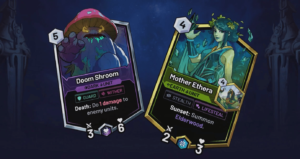
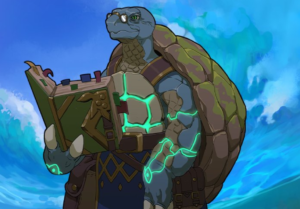
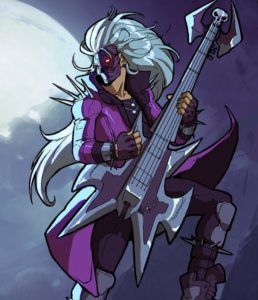


1 thought on “SEEING SKY: STEP 1, STRENGTH – By JustAddBacon”